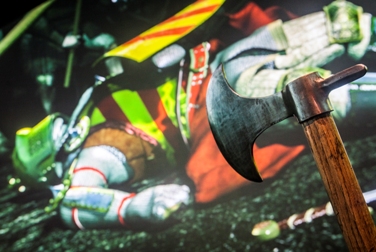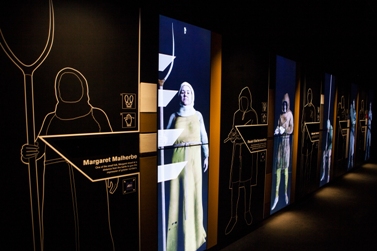The interpretative scheme
The absence of an archaeological record was one of the creative challenges faced by interpretative designers Bright White, the York-based company employed to deliver the new interpretation. Rather than working with physical objects from the archaeological record, they worked with the historical record and introduced gameplay dynamics into the visit. They invented an experience – housed within a discrete new building by Reiach and Hall architects – which places the visitor in a compelling immersive 3D visualisation of the Scots and English armies on the brink of battle: Human scale digital characters line up to share their personal stories and tactical tips, while crossbowmen loose their bolts across the room and cavalry bear down on you …
This area is intended to prepare visitors for the next part of the experience, which takes place in the Battle Room. Here, visitors take an active role in a re-invention of the battle played on an inter-active simulator. Visitors become military commanders, making strategic decisions which are played out by miniature armies across a sumptuous model of the local area. At the end of the game, the medieval terrain dissolves into the 2014 Stirling landscape. At this point, one visitor realises that, in contrast to the events of 1314, she has just won the ‘Battle of the Next’, with the decisive action occurring on the site of her local shopping centre. It’s a learning journey she’s not likely to forget.
Academic rigour
One of the challenges of this project was to make the interpretative content as historically robust as possible. The role of the project’s academic advisory panel was crucial to this, and it was fascinating to see how the project challenged and inspired them to think visually.
An extensive and highly detailed brief was developed for the digital design team at CDDV (Centre for Digital Design & Visualisation) to create the virtual armies which appear in the centre. The brief draws from a wide variety of historical sources, and contains carefully reasoned assumptions and justifications for the appearance of the combatants, in the absence of decisive evidence. The quality of the brief facilitated the production of highly detailed and realistic 3D assets – a digital armoury with untold learning potential, which sets a new benchmark for the authentic visualisation of Scottish medieval fighting men.

In parallel, the project team used highly detailed aerial scan data and worked with paleo-environmental archaeologists at Stirling University, to develop the battle simulator. By examining ancient pollen samples taken from the area, the archaeologists were able to determine quite precisely the extents and characteristics of bogs, marshes, woodland and rivers on the battlefield in June 1314. Thus, the topography and natural obstacles players encounter in the battle game are as real as can possibly be known.
Project management
The project involved some innovative partnerships between a government department (Historic Scotland), a charity (the National Trust for Scotland), a private company (Bright White) and an FE establishment (CDDV). Those involved learned about the significant differences in language, culture and approach which exist between the organisations, as well as the exciting creative potential of such collaborations.
For example, the 3D digital design process was extremely specialised and labour intensive. This meant the team had to work hard to establish a common understanding of what the content development process entailed, and where the risks and dependencies lay. Client and academic panel approvals needed to be carefully managed, to ensure production stayed on programme. Bright White’s previous experience of managing the development of 3D stereoscopic environments was crucial to the success of the operation.
What’s more, despite extensive prototype testing activities, it was impossible to know fully what the final visitor experience would be like prior to installation because of the highly innovative and immersive nature of the interpretation. As per the medieval mind set, a little faith was required (and ultimately rewarded).
Interpreting an iconic site
The immoveable event of the 700th anniversary of the battle in June 2014 posed both an opportunity and a challenge in terms of project delivery. 2014 is also, as it turned out, the year of the Scottish Referendum. Part of the challenge of interpreting such an iconic battle site at a significant time such as this is to explore which side of ‘ourselves’ we want to present to the world. The cutting edge 3D immersive experience, which showcases the best digital design talent in the country, hopefully shows something of what Scotland is now.

However, the challenge is also to properly understand, and effectively enhance the sense of place. As visitors enter into the landscape from the centre and approach the newly conserved monuments, they move from the intensity of two days of battle to a more reflective outdoor space. When they encounter the monumental bronze statue of King Robert scanning the horizon for Edward’s advancing army, they will hopefully better appreciate that he was outnumbered, and the strategic military achievement of winning against a larger and better equipped force. In short, I like to think Bruce would have approved.
Tom Ingrey-Counter is Interpretation Sub-Project Manager for the Battle of Bannockburn. He works for the National Trust for Scotland.
Chris Walker, MD of Bright White, talked to Advisor to explain how a desire to engage audiences in an innovative way led to the development of this fully digital visitor experience.
When we started work on this project, we set out to create a form of interpretation that would be relevant to the 2014 audience. We were also targeting the difficult to reach age group of 10-16 year olds. We were all of the mind that, given the emotional and dynamic nature of medieval battle, we needed to look for ways to give the audience real agency in their visit to stir those emotions, and complete the sense of immersion in the subject . What has been created is, as far as we know, the first 100% digital, large scale interpretation centre. This is predominantly because of the lack of objects but also because of the drive from the client (both National Trust Scotland and Historic Scotland) to do something different and to turn the lack of objects into a strength.

With not a single object in existence attributable to the Battle of Bannockburn, it could have been very limiting for us as interpretation designers. However, the fantastic historical and written records and chronicles from the time allowed us to work with leading academics who wove together all of these sources into reference that was incredibly coherent, and we could not have done it without them.
We also collaborated with Glasgow School of Art who have an amazing digital design studio and their capability opened up lots of different options for us. In the process the team has created a huge digital archive of clothing and weaponry across ranks and even animals. These virtual objects may not be tangible but they still have many of the virtues of a real object.
The immersive space which exists before the battle simulator allows us to take people who have absolutely no knowledge of medieval warfare through a series of scenarios which do things as simple as demonstrating what weaponry was used at the time. The different scenarios are played out in 3D with the audience ‘trapped’ in the middle of a huge virtual field.
In the flanks of the space are interactive virtual characters from each side, designed to give you the wider socio-political picture of who was fighting, where they were from and what their lives were like. It allows you to come face to face with participants in the battle.

The battle simulator forms the core of the visit. We have created a historically accurate landscape with accurate military divisions which can be controlled by up to 30 players at a time. When schools arrange a visit to Bannockburn they are provided with materials some weeks beforehand which help them to explore the socio-political environment of 1314; how it is changing, why it is changing and why these two armies will meet at Bannockburn. When they come to the centre they know that they will manage the fight and this unique facility gives them a very immersive and participatory experience as they take control of the representations of the English and Scots armies of 1314. Visitors are told that to stand the best chance of winning they need to listen to what the people on the battlefield are telling them. Within each display are tips on how to win which ensures that they go through every display in fine detail in order to try to be the victors. Participants are not just watching passively; they influence the outcome. In the 2014 version of the battle England might win! In any case, the battle master who manages each ‘game’ then takes them through what actually happened in 1314 and draws comparisons.
Aside from the lack of objects, one of the major challenges for us was that the main activity (the battle) is digital and a ticketed event. It has to work. We ensured that the AV element was designed very early on so that capital refreshment costs and maintenance could be built into the business plan. Digital innovation is in the project’s DNA, and that requires effective management of risk.
Another challenge was working across so many sectors (charity, government departments, higher education and private companies). This meant that cultural familiarity had to be built as we went along, but it has been incredibly rewarding and successful.
At the Museums + Heritage Show this year we will be showing the next generation of what this technology can do. Our whole team is very excited at our ability to deliver these large, innovative projects.
Hear more about this project at this year’s Museums + Heritage Show
Key information:
Reiach & Hall – Architects | Bright White – Interpretation Concept, Design & Build | Historic Scotland – Project Management | CDDV – 3D Media Research & Development | Ian White Associates – Landscape Architects
Back to top




